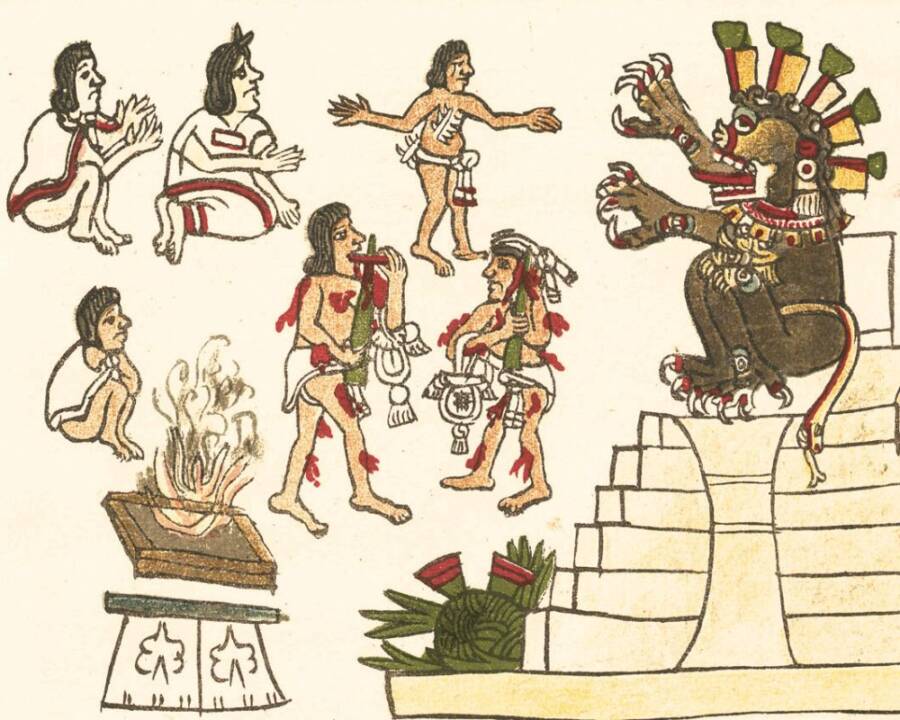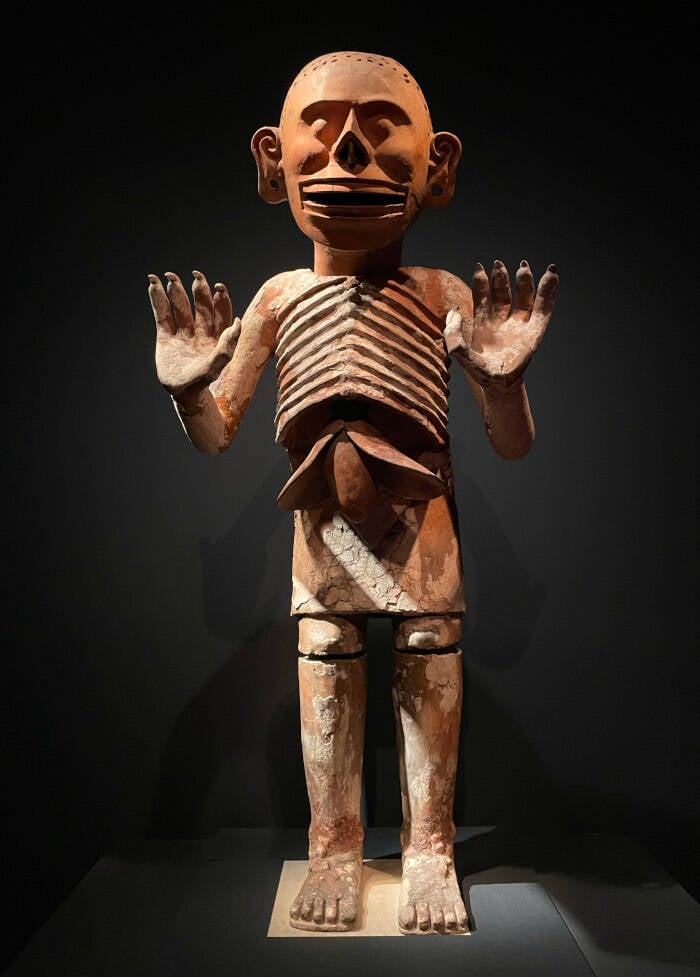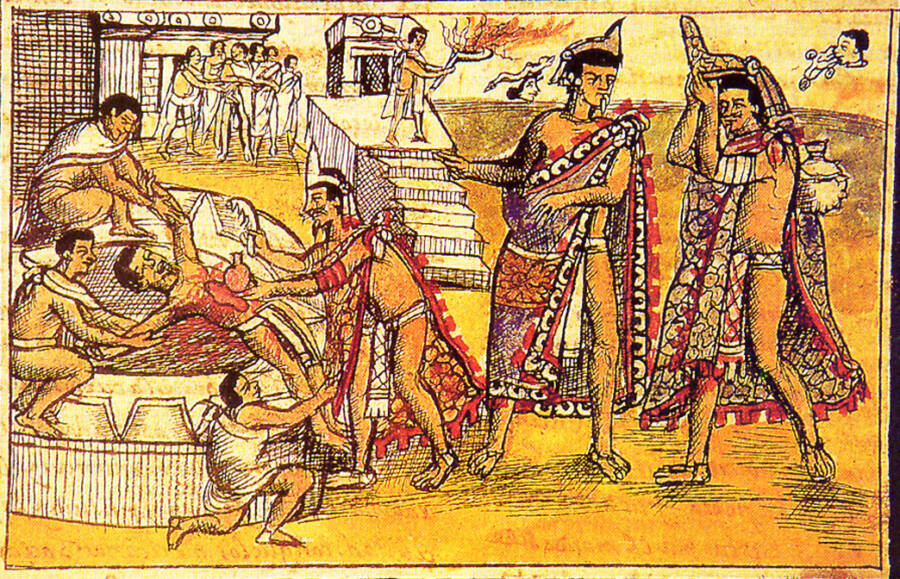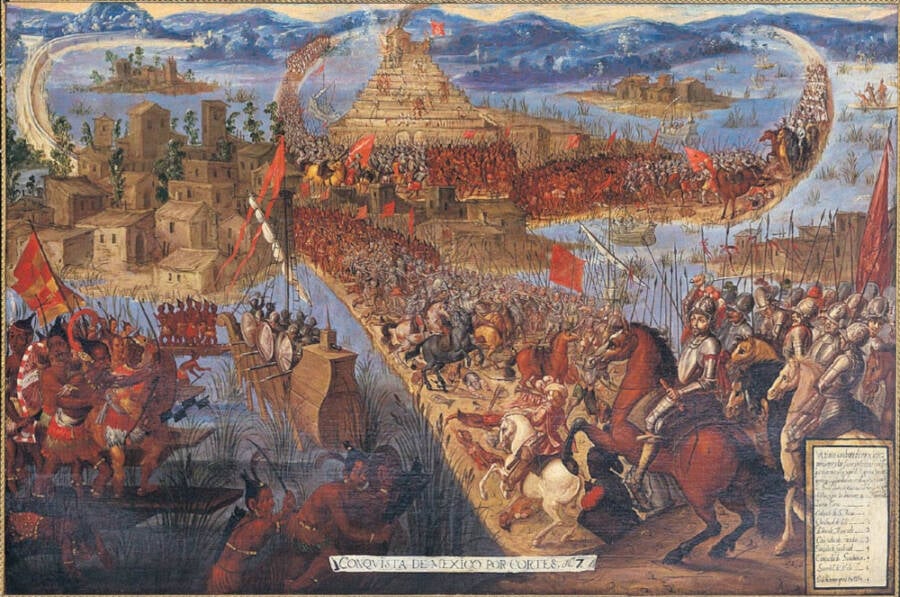Mictlantecuhtli was a menacing Aztec deity who oversaw the underworld, Mictlan, rewarding the dead who completed the four-year journey to its deepest level with eternal rest.

Public DomainMictlantecuhtli as portrayed in the Codex Magliabechiano.
Though cultures throughout history have had vastly different cuisines, religions, and social norms, one thing is shared in common: death. The inevitability of dying and the mystery of the afterlife have driven many civilizations to worship death gods. While each of these deities is fascinating and important in their own right, few are as strange and terrifying as Mictlantecuhtli.
The Aztec god of death and lord of Mictlan, the lowest realm of the underworld, Mictlantecuhtli’s worship involved frightening rituals of human sacrifice and cannibalism. But he was also a symbol of hope. For those unfortunate souls who made it through his kingdom, eternal rest was the reward for a four-year journey of unimaginable suffering.
This is the legend of Mictlantecuhtli, the “Lord of Mictlan” and one of the most important and powerful gods of the Aztec world.
The Ancient Origins Of Mictlantecuhtli
The Aztecs believed that the universe began with the self-created primordial creator gods Tonacatecuhtli and Tonacacihuatl. These two beings gave birth to four children: Huitzilopochtli, the eventual patron god of Tenochtitlan and the Aztecs, as well as the sun and war; Quetzalcoatl, the god of learning, merchants, wisdom, and the day; Tezcatlipoca, the god of hurricanes and the night sky; and Xipe Totec, “the flayed one,” the deity of rebirth and agriculture.
Each of their four sons was also the lord of one of the principal directions and many other aspects of Aztec life. Quetzalcoatl, for example, was also the god of learning, while his brother Xipe Totec was the patron deity of goldsmiths.
According to Aztec beliefs, 600 years later, these four brothers set about creating the world, including the Sun, maize, the first people, and the Aztec calendar. Finally, they sired Mictlantecuhtli and his wife Mictecacihuatl to rule over the underworld. The lord and lady of death lived in a windowless house filled with bats, owls, and spiders in Mictlan, the lowest circle of the Aztec underworld.

Wikimedia CommonsThe Aztecs believed Tonacatecuhtli and Tonacacihuatl were the ancestors of all 200 gods in their pantheon.
The Aztecs had several names for Mictlantecuhtli, including Nextepehua (“Scatterer of Ashes”), Tzontemoc (“He Who Lowers His Head”), and Ixpuztec (“Broken Face”). They didn’t see Mictlantecuhtli as evil. Instead, he was simply a reflection of their belief that supernatural entities governed every aspect of existence. As such, he was a central deity in the Aztec pantheon and one that almost everyone would have to face on the road to the afterlife.
Mictlantecuhtli’s Place In Aztec Beliefs

Wikimedia Commons/Templo Mayor MuseumA statue of Mictlantecuhtli discovered in the ruins of Templo Mayor, the most important temple in Tenochtitlan.
Mictlantecuhtli’s role was not to judge the dead but rather to maintain order. In a way, he was the Aztec equivalent of Hades. He was unusual among the Aztec gods in that he held sway over all types of the dead. His task was to divide the deceased according to how they had perished.
Innocents, such as children, were destined for Cincalco. Those killed in battle or as sacrifices, along with women who died in childbirth, went to Tonatiuhichan, a paradise in Huitzilopochtli’s palace, where they would eventually be transformed into hummingbirds. Those killed by lightning strikes, water, or certain diseases would pass on to Tlalocan.
All others were doomed to enter Mictlan. There, they would undertake a four-year journey through darkness and tortures like winds of obsidian knives, a void without gravity, and many rivers that they could only cross if their actions in life allowed it. Someone could only cross the first river, for instance, with the help of a spectral dog. If the unfortunate soul had mistreated dogs in life, they would be left to repent their sins on the riverbank for eternity.
Only after passing through these trials would the dead come to the darkest depths of Mictlan. There, they would meditate on the states of consciousness until Mictlantecuhtli allowed them to atone for their failings in life and achieve peace, with their soul dissipating into nothingness.
To the Aztecs, life and death were intimately connected in a continuum of existence. But while he was the lord of the dead, Mictlantecuhtli also played an important part in the Aztecs’ beliefs about how humans came to be.
The Origin Of Humans And Mictlantecuhtli

Special Collections, University of Kentucky LibrariesMictlantecuhtli and Quetzalcoatl as depicted in the Codex Borgia.
The Aztecs believed that the world had gone through five ages, or “suns,” in which it had been destroyed and remade. According to Michael E. Smith’s The Aztecs, the gods Quetzalcoatl and Tezcatlipoca had the task of creating the world a fifth time after a flood destroyed humanity in the fourth age.
After remaking the sky and the land, they needed the bones of the people of the fourth age to recreate humans for the fifth. These bones could only be found in Mictlan, so Quetzalcoatl and Xolotl, the god of fire and lightning, were sent to Mictlan to retrieve them.
Mictlantecuhtli agreed to give up the bones, but he first demanded that Quetzalcoatl walk four times around the land of the dead blowing a conch shell like a horn. Quetzalcoatl passed the test when he summoned worms to bore holes in the shell and bees to fill it to make it sound like a trumpet.
But Mictlantecuhtli changed his mind and had his servants dig a pit to trap Quetzalcoatl. When a quail startled the god, he fell into the pit. There, he fell unconscious while the quail pecked at the bones. Quetzalcoatl eventually awoke, gathered the bones, and left the underworld. He then mixed the bones with his own blood and corn to create the people of the Earth.
Worshipping The God Of Death

Public DomainThe Aztecs believed Mictlantecuhtli and the other gods required human hearts and blood to sustain themselves, and they made sacrifices to keep the deities satisfied.
Like many Mesoamerican cultures, the Aztecs famously practiced human sacrifice. And like other gods, Mictlantecuhtli had to be honored and placated with yearly gifts of blood and souls.
Between December and February, an impersonator of Mictlantecuhtli was taken at night to the temple of Tlalxicco, according to the World History Encyclopedia. The victim’s heart would be cut out and the body eaten. The bones would sometimes be used to make masks representing the lord of Mictlan or the musical instruments used in his ceremonies.
Bones were also an important element in Aztec depictions of the god. Many Aztec deities had skull faces or other skeletal attributes, but Mictlantecuhtli was the only one who was regularly depicted as a crowned skeleton.
Mictlantecuhtli was a focus of Hueymiccaylhuitl, the great feast of the dead, during which the living enacted rituals to guide the souls of the deceased on their journey. The Aztecs celebrated this holiday in the fall, when the days grew darker, symbolizing a transition into a time of seasonal change and greater closeness to Mictlantecuhtli’s realm.

Wikimedia Commons/Library of CongressThe Spanish conquest of Tenochtitlan marked the end of Aztec resistance and the beginning of the decline of their religion.
Per the Museums and Galleries of New South Wales, sacrifices to Mictlantecuhtli weren’t usually extravagant — only Huitzilopochtli demanded human hearts — with just a few victims sacrificed each year. That seems to have changed when the Spanish arrived.
After the Spanish conquest, Mexican scholars claimed that Hernán Cortés’ arrival in 1519 had coincided with the prophesied return of Quetzalcoatl and the end of the world. Hoping to avoid suffering in Mictlan, Aztec emperor Moctezuma II increased the number of sacrifices at the temple of Tlalxicco.
The Spanish soon put an end to the Aztec religion, violently forcing the people of Mexico to convert to Catholicism, and thus Mictlantecuhtli’s worship came to an end. If the stories of Moctezuma’s sacrifices are true, it may be fitting that the god of death, who had played such an important part in the creation myth of the Aztecs, was so honored at its end.
After learning about Mictlantecuhtli, the Aztec god of death, read about the macuahuitl, the fearsome Aztec weapon known as the “obsidian chainsaw.” Then, learn about Anubis, ancient Egypt’s god of the underworld.





